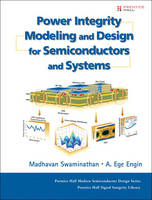
Power Integrity Modeling and Design for Semiconductors and Systems
Prentice Hall (Verlag)
978-0-13-615206-4 (ISBN)
- Titel ist leider vergriffen;
keine Neuauflage - Artikel merken
Using realistic case studies and downloadable software examples, two leading experts demonstrate today's best techniques for designing and modeling interconnects to efficiently distribute power and minimize noise.
The authors carefully introduce the core concepts of power distribution design, systematically present and compare leading techniques for modeling noise, and link these techniques to specific applications. Their many examples range from the simplest (using analytical equations to compute power supply noise) through complex system-level applications.
The authors
Introduce power delivery network components, analysis, high-frequency measurement, and modeling requirements
Thoroughly explain modeling of power/ground planes, including plane behavior, lumped modeling, distributed circuit-based approaches, and much more
Offer in-depth coverage of simultaneous switching noise, including modeling for return currents using time- and frequency-domain analysis
Introduce several leading time-domain simulation methods, such as macromodeling, and discuss their advantages and disadvantages
Present the application of the modeling methods on several advanced case studies that include high-speed servers, high-speed differential signaling, chip package analysis, materials characterization, embedded decoupling capacitors, and electromagnetic bandgap structures
This book's system-level focus and practical examples will make it indispensable for every student and professional concerned with power integrity, including electrical engineers, system designers, signal integrity engineers, and materials scientists. It will also be valuable to developers building software that helps to analyze high-speed systems.
Madhavan Swaminathan received his B.E. in electronics and communication from Regional Engineering College, Tiruchirapalli, in 1985, and his M.S. and Ph.D. in electrical engineering from Syracuse University in 1989 and 1991. He is currently the Joseph M. Pettit Professor in Electronics in the School of Electrical and Computer Engineering and deputy director of the Packaging Research Center, Georgia Tech. He is also the cofounder of Jacket Micro Devices, a company specializing in RF modules for wireless applications. Before joining Georgia Tech, he worked on packaging for supercomputers for IBM. Swaminathan has written more than 300 publications, holds 15 patents, and has been honored as an IEEE Fellow for his work on power delivery. A. Ege Engin received his B.S. and M.S. in electrical engineering from Middle East Technical University, Ankara, Turkey, and from the University of Paderborn, Germany. From 2001 to 2004, he was with the Fraunhofer Institute for Reliability and Microintegration in Berlin. During this time, he also received his Ph.D. from the University of Hannover, Germany. He is currently a research engineer in the School of Electrical and Computer Engineering and an assistant research director of the Packaging Research Center at Georgia Tech. He has more than 50 publications in refereed journals and conferences in the areas of signal and power integrity modeling and simulation.
Preface xiii
Acknowledgments xvii
About the Authors xxiChapter 1: Basic Concepts 11.1 Introduction 1
1.2 Simple Relationships for Power Delivery 10
1.3 Design of PDNs 17
1.4 Components of a PDN 24
1.5 Analysis of PDNs 45
1.6 Chip-Package Antiresonance: An Example 61
1.7 High-Frequency Measurements 65
1.8 Signal Lines Referenced to Planes 71
1.9 PDN Modeling Methodology 77
1.10 Summary 79 Chapter 2: Modeling of Planes 832.1 Introduction 83
2.2 Behavior of Planes 84
2.3 Lumped Modeling Using Partial Inductances 89
2.4 Distributed Circuit-Based Approaches 94
2.5 Discretization-Based Plane Models 117
2.6 Analytical Methods 133
2.7 Multiple Plane Pairs 138
2.8 Summary 169 Chapter 3: Simultaneous Switching Noise 1753.1 Introduction 175
3.2 Simple Models 177
3.3 Modeling of Transmission Lines and Planes 185
3.4 Application of Models in Time-Domain Analysis 209
3.5 Application of Models in Frequency-Domain Analysis 226
3.6 Extension of M-FDM to Incorporate Transmission Lines 233
3.7 Summary 239 Chapter 4: Time-Domain Simulation Methods 2434.1 Introduction 243
4.2 Rational Function Method 244
4.3 Signal Flow Graphs 295
4.4 Modified Nodal Analysis (MNA) 317
4.5 Summary 327 Chapter 5: Applications 3335.1 Introduction 333
5.2 High-Speed Servers 334
5.3 High-Speed Differential Signaling 349
5.4 Analysis of IC Packages 365
5.5 Extraction of Dielectric Constant and Loss Tangent 372
5.6 Embedded Decoupling Capacitors 392
5.7 Electromagnetic Bandgap (EBG) Structures 415
5.8 Future Challenges 443 Appendix A 451A.1 Multiport Networks 451
A.2 Matrix Representation of Transmission Lines 453
A.3 Spectrum of Digital Signals 454 Appendix B: Software List 459Index 461
| Erscheint lt. Verlag | 18.12.2007 |
|---|---|
| Verlagsort | Upper Saddle River |
| Sprache | englisch |
| Maße | 180 x 243 mm |
| Gewicht | 920 g |
| Themenwelt | Technik |
| ISBN-10 | 0-13-615206-6 / 0136152066 |
| ISBN-13 | 978-0-13-615206-4 / 9780136152064 |
| Zustand | Neuware |
| Haben Sie eine Frage zum Produkt? |
aus dem Bereich


